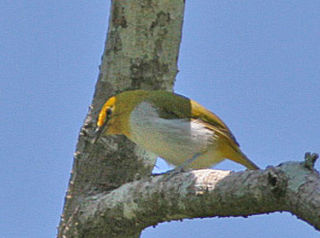
Chalcid wasps are insects within the superfamily Chalcidoidea, part of the order Hymenoptera. The superfamily contains some 22,500 known species, and an estimated total diversity of more than 500,000 species, meaning the vast majority have yet to be discovered and described. The name "chalcid" is often confused with the name "chalcidid", though the latter refers strictly to one constituent family, the Chalcididae, rather than the superfamily as a whole; accordingly, most recent publications (e.g.,) use the name "chalcidoid" when referring to members of the superfamily.
The Old World silversides are a family, Atherinidae, of fish in the order Atheriniformes. Atherinidae are abundant and considered bony fish (teleost) that are widespread globally, living in rivers, estuaries, and coastal waters. They occur worldwide in tropical and temperate waters. About two-thirds of the species are marine, and the remainder live in fresh water. The 74 species are in 13 genera. The genus Craterocephalus is the most diverse with 25 species. Four genera are monotypic.

The Galápagos tortoise or Galápagos giant tortoise is a very large species of tortoise in the genus Chelonoidis. The species comprises 15 subspecies. It is the largest living species of tortoise, and can weigh up to 417 kg (919 lb). They are also the largest extant terrestrial cold-blooded animals (ectotherms).

The Moluccan megapode, also known as Wallace's scrubfowl, Moluccan scrubfowl or painted megapode, is a small, approximately 31 cm long, olive-brown megapode. The genus Eulipoa is monotypic, but the Moluccan megapode is sometimes placed in Megapodius instead. Both sexes are similar with an olive-brown plumage, bluish-grey below, white undertail coverts, brown iris, bare pink facial skin, bluish-yellow bill and dark olive legs. There are light grey stripes on reddish-maroon feathers on its back. The young has brownish plumage, a black bill, legs and hazel iris.

Ornithoptera croesus, the Wallace's golden birdwing, is a species of birdwing butterfly found in northern Maluku in Indonesia.
The Georgia blind salamander is a species of salamander in the family Plethodontidae. It is endemic to the south-eastern United States where its natural habitats are inland karsts, caves and subterranean habitats. It is listed as "Endangered" by the IUCN and is threatened by habitat loss.

The plumbeous pigeon is a species of bird in the family Columbidae. It is found in Bolivia, Brazil, Colombia, Ecuador, French Guiana, Guyana, Panama, Paraguay, Peru, Suriname, and Venezuela.

The yellow-ringed white-eye is a species of bird in the family Zosteropidae. It is found in the Lesser Sunda Islands.

The scarlet-banded barbet is a species of bird in the New World barbet family, Capitonidae. It is endemic to Peru.

The Wallace's or Sulawesi stripe-faced fruit bat is a species of megabat in the family Pteropodidae. It is endemic to Sulawesi and the nearby Togian Islands of Indonesia. Cave paintings resembling these bats have been found in Australia, where bats of this kind are not otherwise known.

Murrindalaspis is an extinct genus of acanthothoracid placoderm found in the McLarty Member of the Murrindal Limestone, of the Early Devonian-aged Buchan Group in eastern Victoria, Australia. Murrindalaspis differs from other acanthothoracids by having a dorsal plate with a large, blade-like flattened, recurved crest emanating from the medial line, and no ventral keel. So far, the genus is known only from dorsal plates and ossified eyeballs. The genus differs from the closely related Weejasperaspis in that the dorsal crest of the latter is shorter, and triangular-shaped.

Wallace's dasyure or Wallace's three-striped dasyure is a member of the order Dasyuromorphia. This marsupial carnivore is found in Indonesia and Papua New Guinea. Specifically, it is found on the Aru Islands of the Maluku Province of Indonesia.

Amata wallacei is a species of moth in the family Erebidae first described by Frederic Moore in 1859. It is found on Java, Sumatra, Peninsular Malaysia and Borneo.

Mecocerus is a genus of beetle belonging to the family Anthribidae.
Wallace's tarsier, Tarsius wallacei, is a species of Sulawesi tarsier. It is found in the forests of what is referred to geologically as the neck of Sulawesi where there are two separate populations. It is a small brown arboreal primate of the infraorder Tarsiiformes less than 15 cm (6 in) long.
Omoglymmius wallacei is a species of beetle in the subfamily Rhysodinae. It was described by R.T. Bell & J.R. Bell in 1988. It is known from lower montane forest on Mount Ambang near Kotamobagu, North Sulawesi (Indonesia). The specific name commemorates Alfred Russel Wallace, pioneering scientist who worked in the region, as well as "Project Wallace", during which the type series was collected (1985).

Heliconius wallacei, the Wallace's longwing, is a butterfly of the family Nymphalidae. It was described by Tryon Reakirt in 1866. It is found from Venezuela and Trinidad to southern Brazil and Peru. The habitat consists of lowland rainforests.

Platystomos wallacei is a species of beetle belonging to the family Anthribidae, the fungus weevils.

Ischiopsopha wallacei yorkiana are beetles in Australia from the family Scarabaeidae, subfamily Cetoniinae, tribe Schizorhinini. It is a sub-species of Ischiopsopha wallacei. The Cetoniinae scarabs are known as "flower chafers" as their main food is pollen and nectar sourced from flowers.
Doddifoenus wallacei is a species of wasp in the family Pelecinellidae. It is the largest known species in the superfamily Chalcidoidea.














